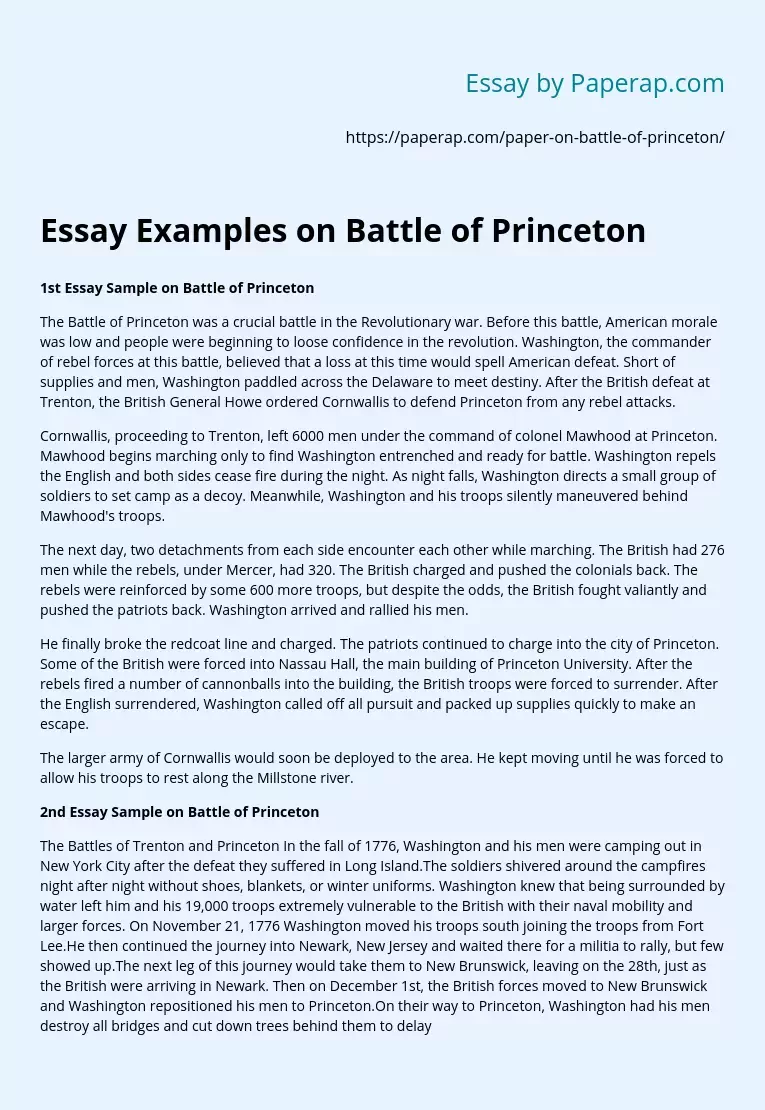Essay Examples on Battle of Princeton
1st Essay Sample on Battle of Princeton
The Battle of Princeton was a crucial battle in the Revolutionary war. Before this battle, American morale was low and people were beginning to loose confidence in the revolution. Washington, the commander of rebel forces at this battle, believed that a loss at this time would spell American defeat. Short of supplies and men, Washington paddled across the Delaware to meet destiny. After the British defeat at Trenton, the British General Howe ordered Cornwallis to defend Princeton from any rebel attacks.
Cornwallis, proceeding to Trenton, left 6000 men under the command of colonel Mawhood at Princeton. Mawhood begins marching only to find Washington entrenched and ready for battle. Washington repels the English and both sides cease fire during the night. As night falls, Washington directs a small group of soldiers to set camp as a decoy. Meanwhile, Washington and his troops silently maneuvered behind Mawhood’s troops.
The next day, two detachments from each side encounter each other while marching.
The British had 276 men while the rebels, under Mercer, had 320. The British charged and pushed the colonials back. The rebels were reinforced by some 600 more troops, but despite the odds, the British fought valiantly and pushed the patriots back. Washington arrived and rallied his men.
He finally broke the redcoat line and charged. The patriots continued to charge into the city of Princeton. Some of the British were forced into Nassau Hall, the main building of Princeton University. After the rebels fired a number of cannonballs into the building, the British troops were forced to surrender.
After the English surrendered, Washington called off all pursuit and packed up supplies quickly to make an escape.
The larger army of Cornwallis would soon be deployed to the area. He kept moving until he was forced to allow his troops to rest along the Millstone river.
2nd Essay Sample on Battle of Princeton
The Battles of Trenton and Princeton In the fall of 1776, Washington and his men were camping out in New York City after the defeat they suffered in Long Island.The soldiers shivered around the campfires night after night without shoes, blankets, or winter uniforms. Washington knew that being surrounded by water left him and his 19,000 troops extremely vulnerable to the British with their naval mobility and larger forces. On November 21, 1776 Washington moved his troops south joining the troops from Fort Lee.He then continued the journey into Newark, New Jersey and waited there for a militia to rally, but few showed up.The next leg of this journey would take them to New Brunswick, leaving on the 28th, just as the British were arriving in Newark. Then on December 1st, the British forces moved to New Brunswick and Washington repositioned his men to Princeton.On their way to Princeton, Washington had his men destroy all bridges and cut down trees behind them to delay the British who were in pursuit of the American army. Once they had reached Princeton, the Americans fell back to Trenton along the Delaware River, which is the border with Pennsylvania.Then on December 2nd, two thousand Pennsylvania militiamen joined Washington at Trenton.
Most men decided to stay home to protect their families from the enemy and any valuable possessions from the British and Hessians. The British and Hessians at this time were destroying Jersey homes, farms and possessions as they moved through the state.As Washington moved to Princeton, General Greene was faced with the advancing British and was forced to retreat. Joining Washington, the combined army now moved back to Trenton and then across the river. Washington had every boat that could be found moved to safety across to the Pennsylvania side. Reaching the Delaware on the 8th, Howe positioned himself across the river.
Essay Examples on Battle of Princeton. (2019, Oct 10). Retrieved from https://paperap.com/paper-on-battle-of-princeton/

